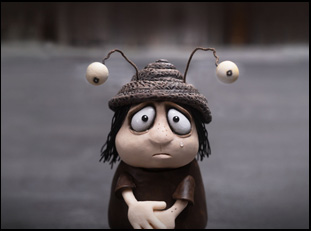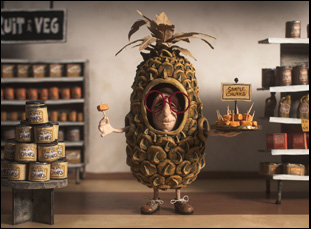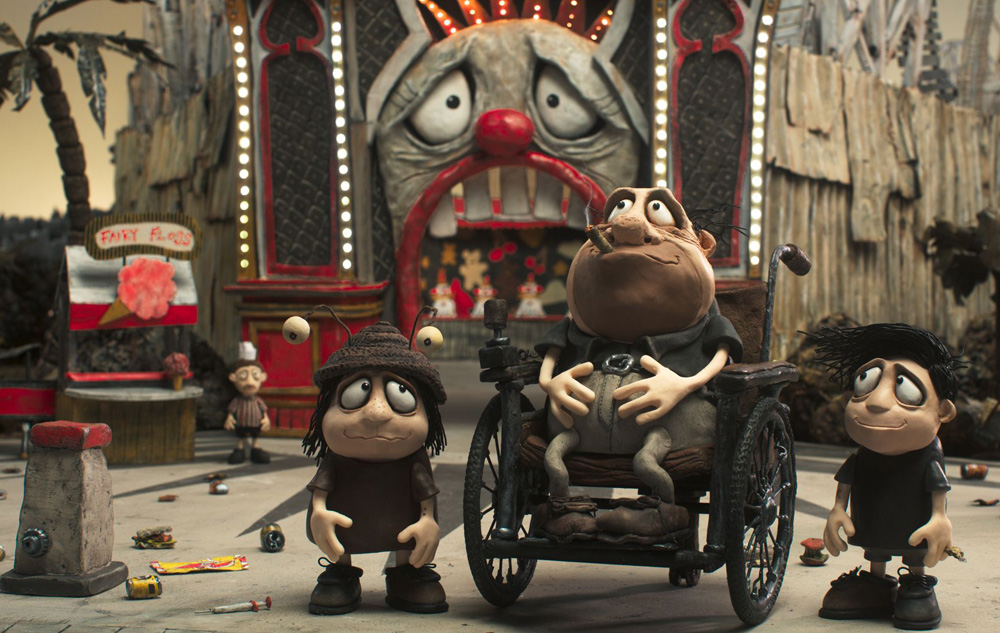Every since Adam Elliot began his career in stop-motion animation, he’s insisted on making a connection between his characters and the audience with their eyes, specializing in big, bulbous peepers that are impossible to look away from and when trained directly at you, make one forget entirely that they have merely a magnet covered in plasticine for pupils when they stare straight into your soul. It’s why breaking the fourth wall remains one of his favorite things to do.
“What I strive for, which I think most filmmakers want, is empathy,” says Elliot. “We really want the audiences to like our characters even if they’re evil, but to be on their side, to put themselves in their shoes and experience what it is like to be them. My characters have all had very traumatic — a lot of loss, a lot of suffering and I’m really trying to get the audience to understand what it is like to be them. Particularly when these little characters are blobs of of clay, trying to get the audience to believe they have a soul and a heartbeat is very tricky.”
It’s a trick that Elliot has magically pulled off time and again, first coming to international renown with his Oscar-winning 2003 short “Harvey Krumpet” where his original voice was clear as he used the form to tenderly tell the story of a man with Tourette’s Syndrome, not ignoring the absurdity of a disease where you can’t control you say. His characters generally contend with forces out of their control, centering his first feature “Mary and Max” around a pair of pen pals whose sense of isolation is what connects them when one is a middle-aged New Yorker living with Asperger’s and the other is an eight-year-old Aussie without many friends, but they are quite literally the product of extraordinary care and consideration as a small team of animators shapes each by hand and guides their every movement.
A notoriously tough process that inevitably makes the humor a little sharper and emotions a little deeper when much like the characters’ experience on screen, every bit of life is hard won, it usually requires the better part of a decade for Elliot to complete a project, making the arrival of his second feature “Memoir of a Snail,” which has actually been in mind for 15 years, a major event. It’s been time well spent, as Elliot and crew have delivered an utterly disarming tale set in Melbourne where the director came of age and follows the divergent paths of Grace (Sarah Snook) and Gilbert (Kodi Smit-McPhee), twins who are separated before their teenage years when their parents both pass away, with their mother’s fandom of Sylvia Plath leading to a tragic end and their vaudevillian father Percy (Dominique Pinon) confined to a wheelchair after a stunt gone bad until eventually succumbing to a final resting place. The two keep in touch via letters as they find separate homes — Gilbert is placed at an apple farm run by ultra-devout Christians by social services and after being taken in by a pair of permissive swingers, Grace ends up in the care of Pinky, a vivacious octogenarian whose husbands have a way of disappearing on her.
Still, Grace’s only company when “Memoir of a Snail” begins is a gastropod named Sylvia (her mother’s influence), part of an entire collection that Grace has kept up over the years when it’s one of the few things that gives her comfort and a connection with her mom, and the film untangles a history of bad breaks that have seemingly made her an eternal orphan and gradually coming to realize the strength it’s taken to carry on for as long as she has. If laughing at misfortune has gotten Grace through life, Elliot doesn’t spare any jokes when clever visual gags can be found in every background and Pinky counts John Denver amongst her sexual conquests back in the day, but it is only one aspect of the grand display of humanity that the director puts on when the more fanciful aspects of the presentation end up pulling one closer to the heart of the matter.
The film has moved audiences already from France, where it won the Annecy Animation Festival’s top prize upon its world premiere, to England, where it was just crowned best feature at BFI London Film Fest, and with the director making the trip to Los Angeles this week as it starts its U.S. theatrical run, Elliot graciously took the time to talk about how “Memoir of a Snail” took shape, the tireless dedication of his team of animators and breaking new ground for himself and the form.

Originally, it was “Memoir of a Ladybird,” but after a couple of drafts, it was all getting a bit cutesy and twee and saccharine. I thought, “No, there must be a better creature than a ladybird.” And I thought of dogs and pigs and ducks and the other things that people collect, but snails just felt right. There was a lot of symbolism and metaphors that I really liked. For example, you touch a snail’s antenna and they retract into their shells. That’s really what Grace is doing her whole life. She’s retracting from the world and going into the protection of her hoard and using her hoard as a shield or a shell. But also, I just love the swirl on the snail’s shell. That’s a lovely symbol of life going full circle and a lovely visual motif to have throughout the film. I also discovered only recently that snails can’t reverse. They can go around in circles, but they can’t go backwards and that tied in really nicely with the quote I love, which is that “Life can only be understood backwards, we have to live it forwards,” by the very famous philosopher Søren Kierkegaard, so there was lots of little links and tie-ins that I really liked about snails.
You’ve said that you had all of these scattered thoughts of things you’d like to see in a film — scenes involving dancing at schnitzel bars and guinea pigs mating — before a story comes into focus. How did a backbone emerge?
Good question, because it’s a very dense film and I’ve really crammed as many jokes in there as possible and as many sad and poignant moments as well. I think the problem for me is that there’s so much I want to say and do with my films, there’s always stuff I have to leave out, so it’s a real Sophie’s Choice about what to keep and what to let go. I wish the film could have been a 10-hour film, but of course the audience wouldn’t be able to tolerate that.
I suspect you could’ve made it work, given how entertaining this is. Most animation has to have a story really be set in stone before production can start on it, but when you lean on voiceover and the process takes many years, does that allow you more flexibility in allowing the story or the tone of it to change as you continue to work on it?
Yeah, I use narration and voiceover primarily for economical reasons because it just saves us a lot of money. Being an independent filmmaker, our budgets are lower, so we have to be very innovative and inventive and very early on — well, 28 years ago — I discovered how useful voiceover can be. It can also be overbearing and too much, so we really go through a very rigorous process of distillation to really pare back the dialogue and voiceover as much as possible, applying that rule, show it, don’t say it. But I love films that are narrated because you get this wonderful intimacy. It really draws the viewer in and you can make a very personal film. They’re the films I always gravitate to — films that are a gentler, softer, and more personal.
When you’ve called the animators your main actors with all the time they spend literally shaping the characters, do you actually see bits of their personality come through in the final product?
Yeah, each of the animators, of course, have their own personalities and strengths. Some of them are really good with comedy and others are much better with poignancy, so I really try and let them inhabit the characters and bring a lot of their own personal touches to the shots they do. At the same time, we have to make sure that the film is consistent. We had seven animators and they all did things slightly different to each other, so it is my job as a director is to wrangle them and make sure that we’re all on the same page. And yes, they are our actors. The voice talent in the film is wonderful, but they only come in for a small period of time. It’s the poor animators who are locked away for 33 weeks animating between five and ten seconds a day in the dark, standing up. It’s a very grueling art form, so I try and give them as much credit as possible.

We love putting in as many cookies and little eggs as possible. In this film, one of my animators actually cut off the tip of her finger and we wrapped her finger up and raced her off to the doctor. But then a few days later, we found her fingertip on the ground, and we thought, “What are we going to do with this?” So we put it in a little tiny jar and put a little tiny cork in the top and it appears three or four times throughout the film in different backgrounds, amongst Grace’s horde. So it’s a bit macabre, and it’s a weird thing to do, but we [thought] why not?
It fits right into the darkly humorous world you create. And you pay great homage to Jean-Pierre Jeunet, with whom you clearly share a sense of humor, when the opening showing all Grace’s hoard mirrors “Delicatessen.” You also cast Dominique Pinon, a regular in his films, to play Percy, Grace’s father who like your own is a vaudevillian. What went into that character?
Sure, my father, who’s no longer with us was a vaudevillian, but he wasn’t an alcoholic paraplegic [like Percy], I must stress that. I was always loved, but we loved making fun of my dad and he led a very colorful, interesting life as an entertainer traveling around the world. In this film, I wanted to make him French and I do love the films of Jean-Pierre Jeunet, so I originally asked Jean-Pierre if he wanted to voice Percy, but he said, “No, no, I can’t. I don’t want to act. But what about my my friend Dominique Pinon?” And I said, “Are you kidding? Of course, I’d love to have Dominique who of course is the lead in Delicatessen and appears in nearly all of Jean-Pierre’s films.” And it was a dream come true to have him as Percy. He was just incredible.
Was there anything in this film either technically or thematically you had been thinking about for a while but waiting for the right opportunity to try and pull it off?
I’d never really done an action sequence. Also, I really wanted to deal with some really challenging subject matter for the audience that really made them think, so we put in this whole sequence that deals with gay conversion, which of course is a very serious subject. I have friends who’ve gone through that horrible process and it was very dynamic to shoot. It is very alarming and confronting to audiences, but we felt it was really important to deal with subject matter that is challenging because why not? Why shouldn’t animation be a vehicle for dealing with taboo subjects?
I’ve always seen animation as not being a genre, but a medium. And there’s a long history of adult animation, particularly in Eastern Europe. It’s great to see more and more live-action directors too coming and making very dark stop motion films [such as] Guillermo del Toro’s “Pinocchio” and Wes Anderson’s “Isle of Dogs.” It’s great to see that the art form is really moving in different directions and evolving and dealing with tough subjects.
It’s got to be a really special moment when you put music on this and you’ve got a full orchestra behind you. What was that like?
It’s been great having, for the first time, my very good friend Elena Kats-Chernin, Australia’s most famous composer, do a brand new original score for the entire film with the Australian Chamber Orchestra and the Cantillation Choir. Having real music in full 5.1 surround sound, it really elevates the film and I can’t imagine the film without it. The music has been crucial. It’s not just in the background, but it really drives the story and it would be so poorer without it.
Has it been exciting getting it out into the world?
It’s been wonderful. We’ve been so chuffed with the responses. We just won the entire London Film Festival, competing against live-action films and that’s not just good for us, but it’s great for the animation community to know that animated films can compete with live action. It’s all about a good story well told and I think the word’s relieved after eight years of hard work. We’re just relieved that the film’s working for audiences around the world.
“Memoir of a Snail” opens on October 25th in New York at the IFC Center and Los Angeles at the AMC Burbank 16 and the AMC Century City before expanding in the weeks ahead across the country.




